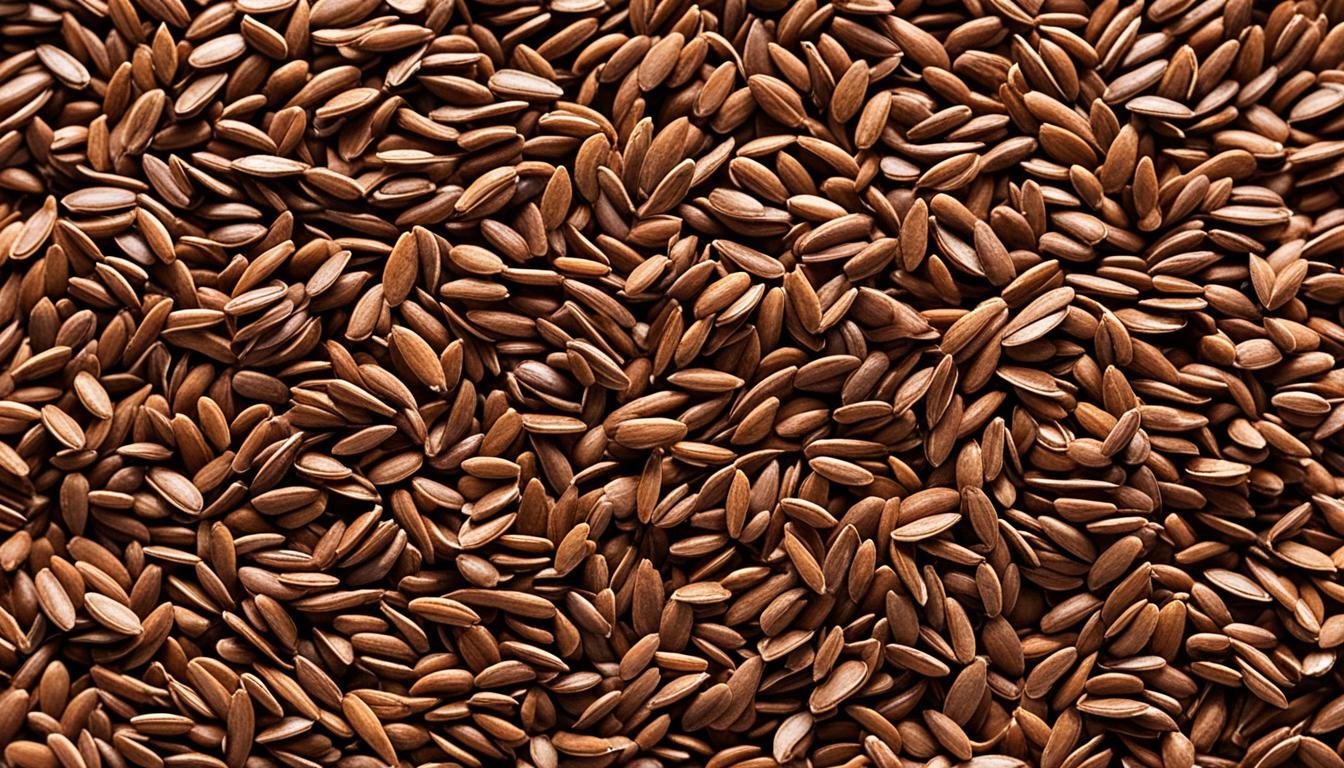Hello everyone, I’m excited to delve into the fascinating world of flax with you. Today, we’ll explore the meaning, benefits, and historical significance of this incredible plant. So, let’s get started!
Flax, scientifically known as Linum Usitatissimum, is a plant that has been cherished for centuries due to its exceptional qualities. It produces flaxseeds, also known as linseeds, which hold immense nutritional value and health benefits.
Flaxseeds are packed with essential nutrients like protein, dietary fiber, B vitamins, and minerals such as iron, calcium, magnesium, phosphorus, and potassium. They are also an outstanding source of Omega-3 fatty acids, particularly Alpha-Linolenic Acid (ALA).
So, what exactly is flax? Put simply, flax is a remarkable plant that generously bestows us with its nutrient-rich seeds, empowering us to embrace a healthier lifestyle.
Key Takeaways:
- Flax is a plant that produces flaxseeds, which are rich in nutrients.
- Flaxseeds contain protein, dietary fiber, B vitamins, minerals, and Omega-3 fatty acids.
- Flaxseeds offer numerous health benefits, making them a valuable addition to a balanced diet.
- Stay tuned to learn more about the incredible benefits of flaxseeds and how to incorporate them into your everyday life.
- Remember: Flax is not just a plant – it’s a source of vitality and well-being!
The Health Benefits of Flaxseeds
Flaxseeds, also known as linseeds, offer a wide range of health benefits that make them a valuable addition to any diet. These tiny seeds pack a powerful nutritional punch, providing essential nutrients and promoting overall well-being. Here, we delve into the numerous benefits of incorporating flaxseeds into your daily routine.
Digestive Health
The high fiber content in flaxseeds supports healthy digestion. With both soluble and insoluble fiber, flaxseeds can promote regular bowel movements and prevent constipation. By supporting digestive health, flaxseeds contribute to a more comfortable and efficient digestive system.
Cardiovascular Support
Flaxseeds are known for their heart-healthy properties. These nutrient-dense seeds can help lower cholesterol levels and blood pressure, reducing the risk of heart disease. This is thanks to their high content of omega-3 fatty acids, which have anti-inflammatory effects and can help maintain cardiovascular health.
Inflammation Reduction
Another noteworthy benefit of flaxseeds is their ability to reduce inflammation in the body. The omega-3 fatty acids found in flaxseeds have been shown to have anti-inflammatory effects, potentially lowering the risk of chronic diseases such as cancer. Including flaxseeds in your diet can contribute to a healthier inflammatory response.
Blood Sugar Regulation
Flaxseeds may also play a role in stabilizing blood sugar levels. Research suggests that the soluble fiber in flaxseeds can slow down the absorption of sugar into the bloodstream, helping to prevent spikes in blood sugar levels. This can be especially beneficial for individuals with prediabetes or diabetes.
Weight Management
If you’re looking to shed some pounds, flaxseeds can be a helpful addition to your weight loss journey. These seeds are low in carbohydrates but high in fiber and healthy fats, giving you a feeling of fullness and satiety. By incorporating flaxseeds into your meals or snacks, you can support your weight management goals.
Immune System Boost
The nutrients in flaxseeds, including vitamins, minerals, and antioxidants, contribute to a strong and resilient immune system. By supporting immune function, flaxseeds can help protect against common illnesses and boost overall health and well-being.
Menopausal Symptom Relief
For women experiencing menopause, flaxseeds may offer some relief from symptoms such as hot flashes. The lignans present in flaxseeds have estrogen-like properties that can help regulate hormone levels and potentially alleviate menopausal discomfort.
| Health Benefit | Description |
|---|---|
| Digestive Health | Promotes regular bowel movements and prevents constipation |
| Cardiovascular Support | Reduces cholesterol levels and blood pressure, lowering the risk of heart disease |
| Inflammation Reduction | Has anti-inflammatory effects, potentially reducing the risk of chronic diseases |
| Blood Sugar Regulation | Stabilizes blood sugar levels, preventing spikes and crashes |
| Weight Management | Promotes a feeling of fullness and satiety, supporting weight loss goals |
| Immune System Boost | Strengthens the immune system for better overall health |
| Menopausal Symptom Relief | Potentially alleviates hot flashes and hormonal discomfort |
Incorporating flaxseeds into your diet is effortless and versatile. These tiny powerhouses can be sprinkled over salads, added to smoothies, or used as an ingredient in baked goods like muffins or bread. It’s recommended to consume around 1 to 2 tablespoons of ground flaxseeds daily to reap the health benefits.
Now that we’ve explored the health benefits of flaxseeds, let’s move on to the various methods you can use to incorporate these nutritious seeds into your diet.
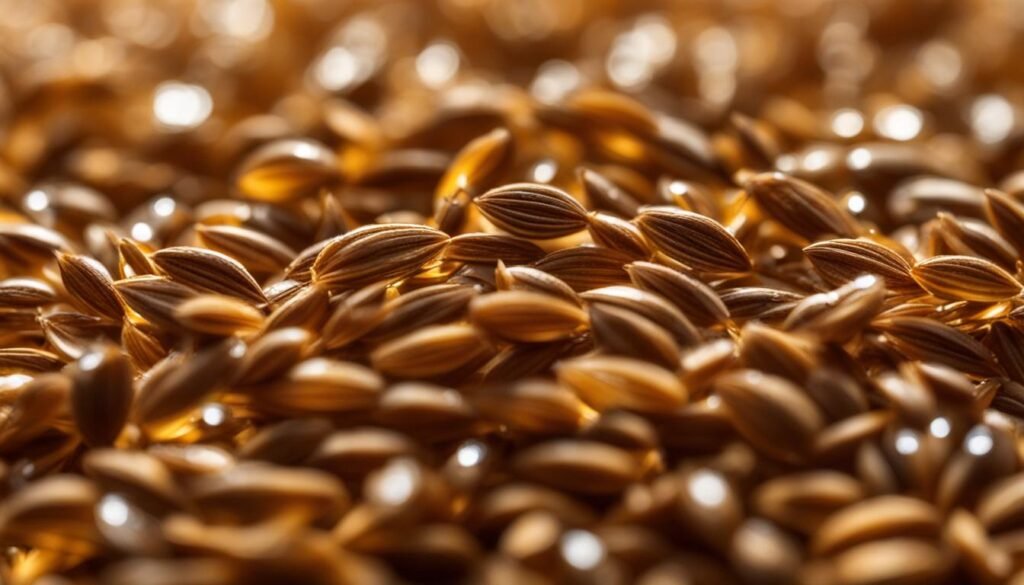
How to Incorporate Flaxseeds into Your Diet
Flaxseeds are a versatile addition to your diet, offering numerous health benefits. Here are some creative ways to incorporate flaxseeds into your meals:
- Whole Flaxseeds: Add whole flaxseeds to salads, baked goods, pancakes, crackers, and smoothies for a crunchy texture and nutty flavor.
- Ground Flaxseeds: It is more beneficial to grind flaxseeds before consuming them. Ground flaxseeds can be added to paranthas, pooris, chutneys, cookies, muffins, bread, and more. Grinding flaxseeds makes them easier to digest and allows for better nutrient absorption.
- Flaxseed Oil: Drizzle flaxseed oil over salads, cooked vegetables, or use it as a base for homemade salad dressings.
- Flaxseed Powder: Mix flaxseed powder into yogurt, smoothies, oatmeal, or even use it as a coating for meats or vegetables.
- Flaxseed Capsules: If you prefer a convenient option, flaxseed capsules are available as a dietary supplement. Follow the recommended dosage for optimal results.
- Flaxseed Flour: Substitute a portion of regular flour with flaxseed flour in baking recipes to increase the nutritional value of your favorite treats.
Remember to start with small amounts and gradually increase the quantity to allow your body to adjust to the fiber content. It is generally recommended to consume 1 tablespoon of whole flaxseeds or flaxseed powder, 1 to 2 tablespoons of flaxseed oil, or 1200 to 3000 mg of flaxseeds in capsule form daily, based on individual needs and preferences.
Experiment with different recipes and find delicious ways to enjoy the benefits of flaxseeds in your daily meals!
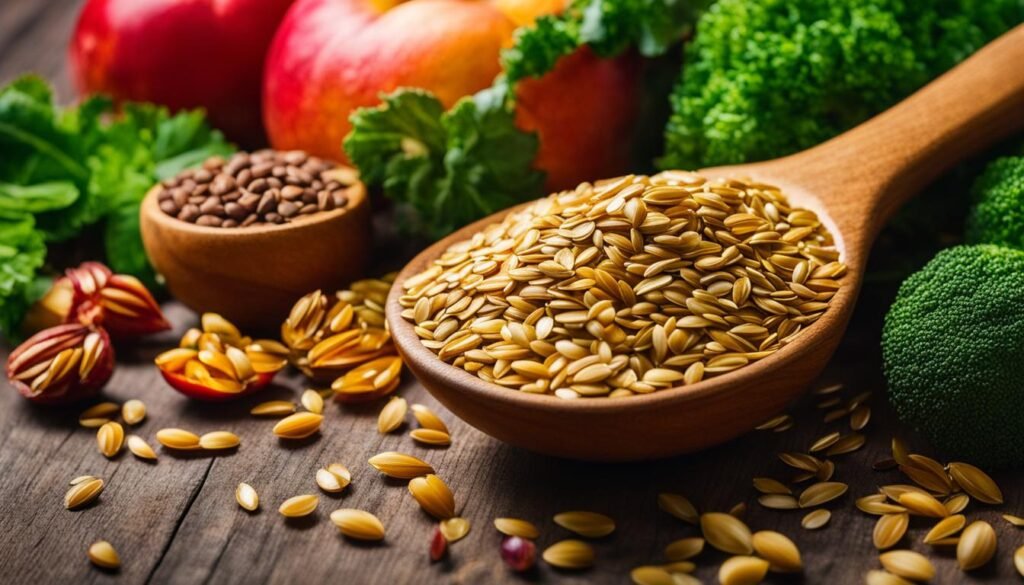
Flaxseed Nutritional Facts
| Nutrient | Amount per 100g |
|---|---|
| Calories | 534 |
| Protein | 18.3g |
| Fat | 42.1g |
| Carbohydrates | 28.9g |
| Fiber | 27.3g |
| Calcium | 255mg |
| Magnesium | 392mg |
| Iron | 5.73mg |
| Potassium | 813mg |
Precautions and Side Effects of Flaxseeds
While incorporating flaxseeds into your diet can offer numerous health benefits, it is important to be aware of some precautions and potential side effects.
Allergies: Some individuals may have allergies to flaxseeds, resulting in symptoms such as itching, swelling, redness, or hives. If you experience any of these symptoms after consuming flaxseeds, it is advisable to discontinue use and consult a healthcare professional.
Potential Inflammation: Flaxseeds contain certain compounds that can promote inflammation if ingested in excessive quantities. It is crucial to consume flaxseeds in moderation to avoid any adverse effects on inflammatory conditions.
Hormonal Balance: Flaxseeds possess estrogen-like properties, which can affect hormonal balance, particularly in individuals with hormone-sensitive conditions. If you have concerns about your hormonal health or are undergoing treatments related to hormonal imbalances, it is recommended to consult with a healthcare professional before incorporating flaxseeds into your diet.
Intestinal Blockage: Flaxseeds are high in dietary fiber, and consuming them without adequate fluid intake can potentially lead to intestinal blockage and constipation. It is essential to drink enough water when consuming flaxseeds to ensure proper digestion and prevent any digestive discomfort.
Consulting a healthcare professional is advised for individuals with specific health concerns such as low blood pressure, low blood sugar levels, constipation, diarrhea, hormonal issues, or bleeding problems before incorporating flaxseeds into their diet.
Example of Flaxseed Allergy Risk
“I experienced itching and redness after consuming flaxseeds in my smoothie. It was frustrating because I had heard about their health benefits and wanted to incorporate them into my daily routine. However, I realized that I might have been allergic to flaxseeds. I consulted my healthcare professional, who confirmed the allergy and advised me to avoid flaxseeds in the future. It’s important to listen to your body and seek guidance if you experience any adverse reactions.”
Preventing Intestinal Blockage Through Hydration
The key to avoiding intestinal blockage and constipation caused by flaxseeds is to ensure you stay hydrated. Drinking enough water alongside incorporating flaxseeds into your diet can promote proper digestion and prevent discomfort. Remember to maintain a balanced fluid intake throughout the day for optimal gut health.
Exploring the Ancient History of Flaxseeds
Flaxseeds have a long and fascinating history that can be traced back to ancient times. These small golden seeds were cultivated since the beginning of civilization, and their uses extended far beyond their well-known health benefits. One remarkable aspect of flaxseeds in ancient history is the creation of the linothorax armor, which was primarily made from linen.
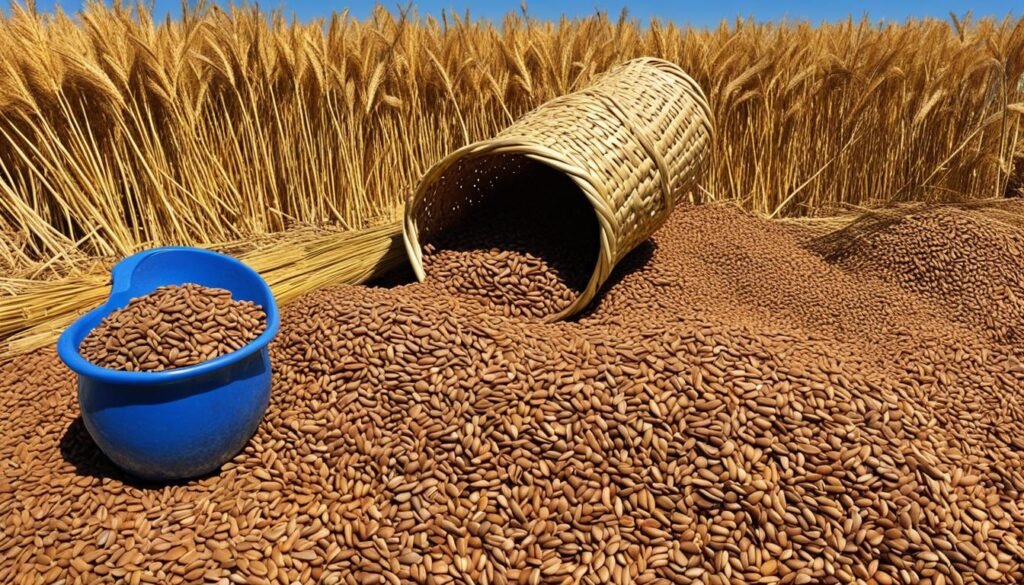
Flaxseeds were used to create textiles even before their health benefits were discovered, showcasing the ingenuity and resourcefulness of ancient civilizations.
The linothorax armor was a popular choice among warriors from the time of Homer through the Hellenistic period. While no original specimens of the linothorax armor remain, ancient images and artifacts have provided valuable insights into its construction and effectiveness. It is through meticulous research and reconstruction that scholars have been able to decipher the secrets of this ancient armor.
- Ancient images: Vase paintings, reliefs, sculptures, and tomb paintings have played a crucial role in understanding the appearance and design of the linothorax armor.
- Artifact examination: The study of related artifacts has provided further clues about the materials used, construction techniques, and the armor’s potential protective capabilities.
Reconstructing the Linothorax Armor
The reconstruction process of the linothorax armor has been a fascinating journey for scholars. Drawing from ancient sources and utilizing their expertise, researchers have pieced together the knowledge required to recreate this ancient armor. The goal has been to achieve historical accuracy and gain insights into the textile technology of the time.
The reconstruction of the linothorax armor demands a deep understanding of ancient textile technology and craftsmanship.
| Challenges in Reconstruction | Approach |
|---|---|
| Finding appropriate materials | Collaborating with experts and sourcing traditional linen grown, harvested, and processed by hand |
| Perfecting the construction process | Utilizing traditional tools and cutting multiple layers of linen |
The meticulous reconstruction process has allowed researchers to gain valuable insights into the construction and potential effectiveness of the linothorax armor. By focusing on historical accuracy and employing traditional methods, scholars have gained a deep appreciation for the craftsmanship of ancient civilizations.
Understanding the Linothorax Armor
Through extensive testing and analysis, scholars have aimed to understand the effectiveness of the reconstructed linothorax armor. Arrow tests, durability tests, and real-life scenarios have been employed to assess the armor’s protective capabilities and validate the research.
The testing process has provided valuable insights into the functionality of the linothorax armor and its potential effectiveness on the battlefield.
| Testing Methods | Insights Gained |
|---|---|
| Arrow tests | Evaluation of the armor’s ability to withstand penetration |
| Durability testing | Simulated combat scenarios to assess the armor’s protective capabilities |
| Real-life scenarios | Validation of the armor’s ability to provide protection in practical situations |
Unlocking the Secrets of Ancient Textiles
The exploration of the linothorax armor and its construction has unveiled the sophisticated textile technology of ancient civilizations. Through the study of flaxseeds, the history of flax, and the reconstruction of the linothorax armor, researchers have gained a deeper understanding of the rich heritage of ancient textiles.
The next section will delve into the challenges encountered during the reconstruction of the linothorax armor and the remarkable experiences of the researchers.
The Quest to Understand the Linothorax Armor
The linothorax armor has captivated researchers in recent years, sparking a wave of extensive research and reconstruction efforts. In an attempt to unravel the secrets of this ancient armor, scholars have embarked on a journey of reverse engineering. Ancient images depicting linothorax-wearing warriors in vase paintings, reliefs, sculptures, and tomb paintings have served as valuable references in this quest.
The study of these images, coupled with careful examinations of related artifacts, has shed light on the construction and potential effectiveness of the linothorax armor. Meticulous examination of ancient texts, visits to museums, and collaborations with experts from various fields have further enriched the research process.
“Ancient images provide glimpses into the remarkable design and craftsmanship of the linothorax armor, enabling us to piece together its structure and purpose,” explains Dr. James Anderson, a leading expert in ancient armor research.
The ancient artifacts associated with the linothorax armor have presented fascinating insights into its construction techniques and materials. Through a meticulous analysis of these artifacts, researchers have been able to reconstruct the armor’s layered composition and understand its potential protective capabilities.
By delving into the realm of ancient images and artifacts, scholars have embarked on a captivating journey of discovery, unearthing the enigmatic world of the linothorax armor and its significance in ancient warfare.
Ancient Images: A Window into the Past
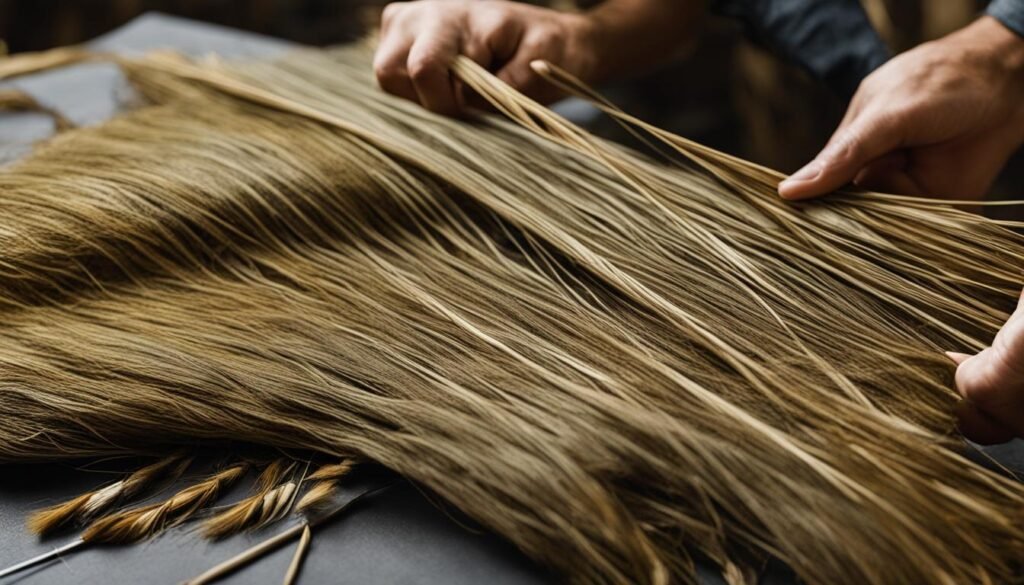
The Challenges in Reconstructing the Linothorax Armor:
| Challenges | Solutions |
|---|---|
| Sourcing authentic materials | Finding a source of handspun and handwoven linen |
| Perfecting the construction process | Utilizing traditional tools and techniques, such as a turkey baster and putty knife, to apply and spread rabbit glue |
Testing the Effectiveness of the Linothorax Armor
To assess the effectiveness of the reconstructed linothorax armor, we conducted extensive testing using various methods and scenarios.
Arrow Tests
In order to measure the armor’s ability to withstand arrow penetration, we conducted arrow tests on laminated linen patches. These tests allowed us to evaluate the armor’s protective capabilities and gauge its effectiveness against projectile attacks.
Durability Testing
To further assess the armor’s durability and protective qualities, we simulated combat scenarios. In these scenarios, students engaged in simulated combat using different weapons and attack techniques, allowing us to evaluate the armor’s resistance to wear and tear.
Real-Life Scenarios
To provide a real-world evaluation of the reconstructed linothorax armor, we conducted tests with a volunteer wearing the armor and being shot with an arrow. This enabled us to validate the armor’s ability to provide protection in practical, real-life scenarios.
These tests not only demonstrated the effectiveness of the linothorax armor but also served to validate our research and reconstruction efforts. The results were crucial in understanding the armor’s protective capabilities and its potential significance in ancient warfare.
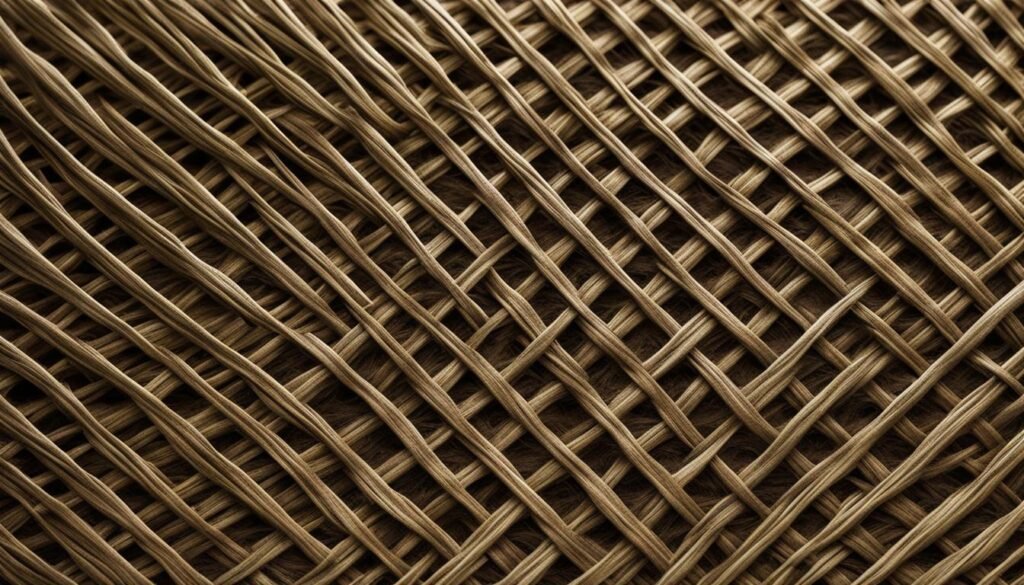
The Fascinating Experiences of Reconstructing the Linothorax Armor
The process of reconstructing the linothorax armor was filled with memorable and unexpected experiences, allowing us to delve into the intriguing world of ancient warfare and textile technology. Behind-the-scenes, hours were spent in libraries and museums, meticulously examining ancient images and artifacts, which granted us new insights and discoveries.
One of the most exciting aspects of this journey was the challenge of sourcing materials and perfecting the construction process. We encountered valuable lessons along the way, emphasizing the dedication required for historical accuracy. It was a reminder that even the smallest details matter when reconstructing ancient artifacts.
“The reconstruction process provided us with a profound sense of connection to the past. Engaging in both scientific and non-scientific testing of the armor added excitement and realism to our research. We were able to hold a tangible piece of history in our hands and witness its potential effectiveness.”
Unexpected discoveries were also made throughout the process, enhancing the authenticity and depth of our understanding. These discoveries ranged from the realization of the intricacies involved in the armor’s construction to the significance of ancient craftsmanship and techniques.
The thrill of scientific and non-scientific testing
To validate our efforts, rigorous testing was conducted on the reconstructed linothorax armor. From arrow tests measuring its ability to withstand penetration, to durability testing simulating combat scenarios, the armor proved its protective capabilities.
But the most unforgettable experience was when a volunteer bravely wore the armor and was shot with an arrow. The adrenaline rush and the sight of the armor functioning precisely as intended were awe-inspiring, fueling our passion for historical exploration.
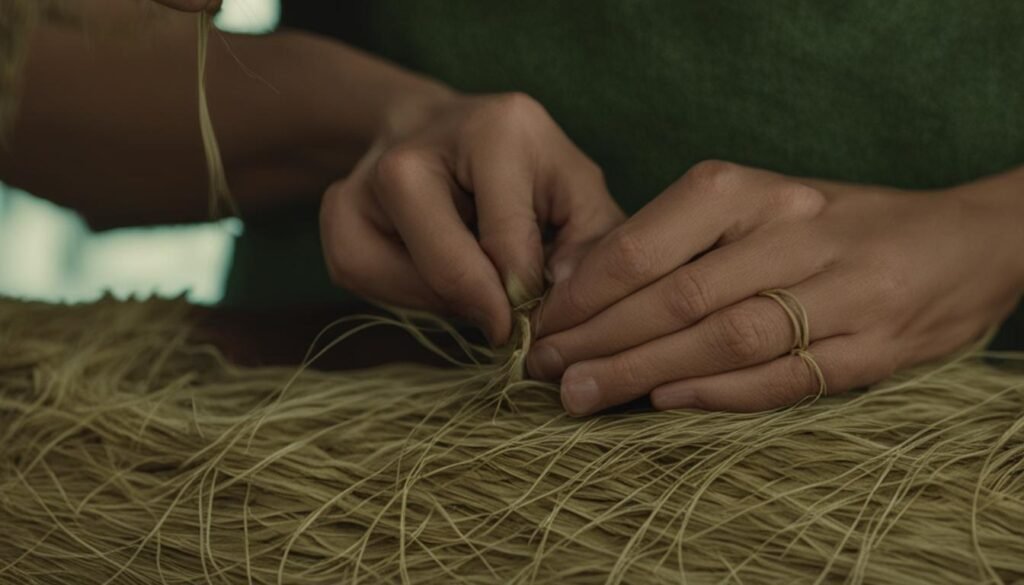
The journey of reconstructing the linothorax armor transported us back in time, allowing us to experience the past in a unique and meaningful way. It was a testament to the power of historical research, unexpected discoveries, and the desire to uncover ancient secrets.
Conclusion
After a deep dive into the world of flaxseeds and the linothorax armor, it is evident that these topics hold immense significance in both ancient history and modern health. Flaxseeds have proven to be a versatile and nutrient-rich superfood, offering a wide array of health benefits that can support overall well-being. From promoting digestion and cardiovascular health to reducing inflammation and aiding weight loss, flaxseeds have cemented their place as a powerhouse of nutrition.
On the other hand, the reconstruction of the linothorax armor has shed light on ancient textile technology and the effectiveness of armor in historical warfare. The meticulous research and testing process have not only provided valuable insights into the construction and potential usage of the linothorax armor but have also enhanced our understanding of ancient culture and the ingenuity of our ancestors.
In conclusion, the exploration of flaxseeds and the linothorax armor has expanded our knowledge and appreciation for these fascinating subjects. The key takeaways from this journey include the recognition of flaxseeds as a superfood packed with essential nutrients and the understanding that the linothorax armor represented a significant advancement in ancient military technology. The historical and practical aspects of flaxseeds and the linothorax armor intertwined to create a comprehensive study that bridges the realms of health, culture, textiles, and warfare.
FAQ
What is the meaning of flax?
Flax is a plant, scientifically known as Linum usitatissimum, that is cultivated worldwide. It has been used for centuries for its versatile fibers and nutritious seeds.
What are the health benefits of flaxseeds?
Flaxseeds are packed with protein, fiber, B vitamins, minerals, and Omega-3 fatty acids. They offer numerous health benefits, including improved digestion, cardiovascular health, anti-inflammatory properties, better blood sugar levels, immune system support, weight management, and relief from menopausal symptoms.
How can I incorporate flaxseeds into my diet?
You can add whole flaxseeds or ground flaxseeds to various dishes like salads, baked goods, smoothies, and more. Flaxseeds are also available in oil, powder, capsule, and flour forms, providing different options for consumption.
Are there any precautions or side effects of consuming flaxseeds?
While flaxseeds are generally safe, some individuals may have allergies to them. Consuming excessive amounts of flaxseeds can worsen inflammation and disrupt hormonal balance. It’s important to consume flaxseeds with enough water to prevent constipation. Consulting a healthcare professional is recommended for specific health conditions.
What is the ancient history of flaxseeds?
Flaxseeds have been cultivated since ancient times and were used to create textiles even before their health benefits were discovered. They have a rich history and cultural significance.
How has the linothorax armor been researched and understood?
The linothorax armor has been studied through the examination of ancient images, artifacts, and texts. Scholars have attempted to reconstruct the armor based on historical sources and collaborative efforts with experts in various fields.
What challenges were faced in reconstructing the linothorax armor?
Challenges included finding traditional materials like handwoven linen and perfecting the construction process using ancient techniques and tools. Cutting multiple layers of linen and applying rabbit glue were aspects that required attention and expertise.
How was the effectiveness of the linothorax armor tested?
Testing involved arrow tests on laminated linen patches and simulated combat scenarios to assess the armor’s protective capabilities. Real-life scenarios, including a volunteer wearing the armor and being shot with an arrow, were also conducted.
What were some memorable and unexpected experiences in reconstructing the linothorax armor?
Hours spent in libraries and museums, challenges in sourcing materials, and engaging in combat scenarios provided memorable and unexpected experiences for the researchers involved, highlighting the dedication required for historical accuracy.
What are the key takeaways from the study of flaxseeds and the linothorax armor?
The study of flaxseeds reveals their rich meaning and significance throughout history, as well as their versatile health benefits. The research and reconstruction of the linothorax armor allow for a deeper understanding of ancient textile technology and the effectiveness of ancient armor.
Source Links
- https://jhupress.wordpress.com/2013/04/24/unraveling-the-linothorax-mystery-or-how-linen-armor-came-to-dominate-our-lives/
- https://timesofindia.com/life-style/health-fitness/diet/10-amazing-health-benefits-of-flaxseeds-and-how-to-consume-them/articleshow/80909274.cms
- https://pharmeasy.in/blog/top-8-health-benefits-of-flaxseeds/
